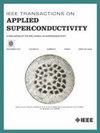叠带电缆电流共享的有限元模拟ICR、ITR、缺陷数和热边界条件的影响
IF 1.7
3区 物理与天体物理
Q3 ENGINEERING, ELECTRICAL & ELECTRONIC
引用次数: 0
摘要
本研究探讨了用于高能物理(HEP)加速器磁体的基于稀土氧化钡铜(ReBCO)的超导电缆中的电流共享和淬火演化。我们使用三维有限元模拟研究了三带堆叠(地毯堆叠)电缆。我们假定每条带长度上的缺陷数量以及带内和带间的指定电阻值和热阻值。之前对三带堆叠电缆中的单个缺陷进行的研究表明,除了带内和带间电阻率外,还需要热阻值和热边界条件来确定电流分担水平。在此,我们将热失控前的电流分担水平定义为 CSR = $I_{{cable}\_{defect}}$/$I_{{cable}\_{no}\_{defect}}$ 。分流水平随串间接触电阻 (ICR)、串间热阻 (ITR) 和热边界条件而变化。举例来说,三带叠层电缆的层间电接触效率为 η = 5400 μΩ*cm2,层间热接触效率为 ω = 5.54 K*m2/W,电缆外表面采用液氦冷却,中央带中有一个缺陷(设定为 10%{I}_{c}}$),其电流分担值为 0.91(即:{I}_{c}}$ 的电流能达到标称电流的 95%)、{I}_{c,cable}}$淬火前达到 95% 的标称{无缺陷} ${I}_{c,cable}}$的能力)。增加中央带中每单位长度的缺陷数量,可实现的 I/${I\neg}_{c,cable}} 从 0.95 降至 0.87。本文章由计算机程序翻译,如有差异,请以英文原文为准。
FEM Modeling of Current Sharing in Tape Stack Cables; Influence of ICR, ITR, Defect Number, and Thermal Boundary Conditions
This research explored current sharing and quench evolution in rare-earth barium copper oxide (ReBCO) based superconducting cables intended for use in the High Energy Physics (HEP) accelerator magnets. We used 3D finite element simulation studies of three-tape stack (carpet stack) cables. A given number of defects per tape length was assumed, along with specified electrical and thermal resistance values within and between tapes. Previous studies with a single defect in a three-tape stack cable showed that in addition to intra and inter-tape electrical resistivity, values of thermal resistivity and thermal boundary conditions were needed to determine a current sharing level. Here we defined the current sharing level as CSR = $I_{{cable}\_{defect}}$ $I_{{cable}\_{no}\_{defect}}$ ${I}_{{c}}$ ${I}_{{c,cable}}$ ${I\neg}_{{c,cable}}\,$
求助全文
通过发布文献求助,成功后即可免费获取论文全文。
去求助
来源期刊

IEEE Transactions on Applied Superconductivity
工程技术-工程:电子与电气
CiteScore
3.50
自引率
33.30%
发文量
650
审稿时长
2.3 months
期刊介绍:
IEEE Transactions on Applied Superconductivity (TAS) contains articles on the applications of superconductivity and other relevant technology. Electronic applications include analog and digital circuits employing thin films and active devices such as Josephson junctions. Large scale applications include magnets for power applications such as motors and generators, for magnetic resonance, for accelerators, and cable applications such as power transmission.
 求助内容:
求助内容: 应助结果提醒方式:
应助结果提醒方式:


